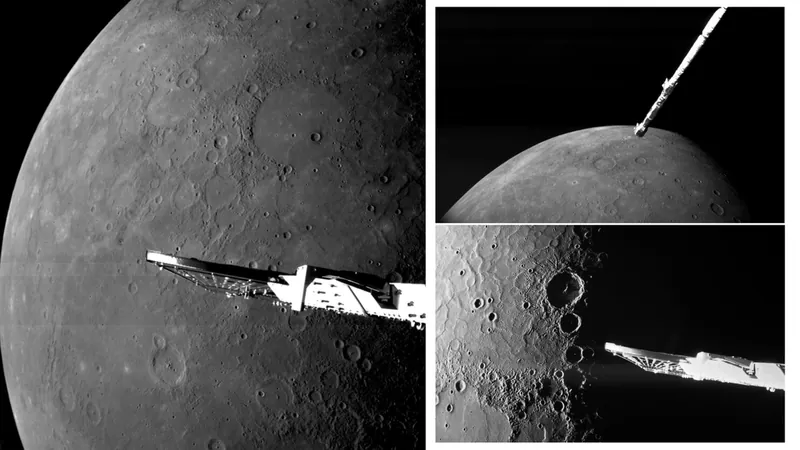
Stunning Revelations from BepiColombo's Final Flyby of Mercury: What Did We Learn?
2025-01-09
Author: Ling
Stunning Revelations from BepiColombo's Final Flyby of Mercury: What Did We Learn?
In a spectacular show of cosmic exploration, the BepiColombo spacecraft has successfully completed its sixth and final flyby of Mercury, delivering breathtaking images and promising insights into the enigmatic planet closest to the Sun. Captured during its flyby on January 8, 2026, these images hint at the tantalizing mysteries that lay ahead for BepiColombo as it prepares to enter Mercury's orbit in 2026.
Launched on October 20, 2018, by the European Space Agency (ESA) and the Japan Aerospace Exploration Agency (JAXA), BepiColombo came within approximately 185 miles (295 kilometers) of Mercury's nightside, navigating the shadows of this intriguing world. Shortly after, the spacecraft soared over the planet's north pole, marking a significant milestone in its mission.
ESA Director General Josef Aschbacher wasted no time in showcasing the remarkable visuals of Mercury during an Annual Press Briefing, which highlights the importance of this mission as BepiColombo gears up for its pivotal orbital insertion on November 21, 2026. Despite the official mission phase not commencing until then, the wealth of information garnered from these flybys has already begun to illuminate Mercury's mysteries.
Project Scientist Geraint Jones emphasized the significance of these flybys, stating, "While the main mission will commence later, our six flybys have unlocked invaluable data about this little-explored planet." In the coming weeks, the team will delve into the findings from the images and data collected during this flyby.
Exploring the Secrets of Mercury's Surface
The BepiColombo images provide a glimpse into Mercury's surface, particularly the striking contrasts seen across the "terminator line," where day meets night. This unique perspective has allowed scientists to peer into some of Mercury's perpetually shadowy craters, notably Prokofiev, Kandinsky, Tolkien, and Gordimer. Surprisingly, these areas are among the coldest in our solar system, with scientific evidence suggesting the presence of water ice—one of the focal points of the upcoming mission.
Interestingly, while Mercury lies closest to the Sun, it is predominantly dark, reflecting only about two-thirds of the light the Moon reflects. This characteristic is advantageous for researchers as bright surface features on Mercury could indicate recent geological activity, allowing for better understanding of the planet's geological history.
Among the remarkable features highlighted in the images is the Nathair Facula, the site of the largest known volcanic eruption on Mercury. With a central vent spanning approximately 25 miles (40 km) wide, this area has hosted multiple significant eruptions, contributing to a vast volcanic deposit stretching about 186 miles (300 km) in diameter.
The Fonteyn impact crater, formed approximately 300 million years ago, also caught scientists' attention with its bright ejecta—material blasted from the surface by past asteroid impacts. During its orbital mission, BepiColombo will further analyze the composition of this volcanic material and examine why certain regions on Mercury's surface darken over time.
The spacecraft's camera also captured sweeping views of Mercury’s vast volcanic plains, known as Borealis Planitia. This serene expanse, shaped by ancient lava flows around 3.7 billion years ago, reveals a rich history of geological activity. The interplay of lava and craters, such as the Henri and Lismer craters, has left marks of a once-thriving volcanic landscape, showcasing the dynamic processes that shaped Mercury's surface.
Additionally, the images reveal Mercury's Caloris Basin—a gargantuan impact crater over 930 miles (1,500 km) wide—along with a peculiar boomerang-shaped lava flow, which raises questions about the planet's volcanic history and movement of material across its surface.
As the BepiColombo team celebrates a successful final flyby, anticipation builds for the upcoming mission phase when they will glean deeper insights into Mercury's geology and atmosphere. The scientific community is eager for what lies ahead, as this mission promises to answer long-standing questions about the origins and evolution of our solar system’s smallest planet.



 Brasil (PT)
Brasil (PT)
 Canada (EN)
Canada (EN)
 Chile (ES)
Chile (ES)
 Česko (CS)
Česko (CS)
 대한민국 (KO)
대한민국 (KO)
 España (ES)
España (ES)
 France (FR)
France (FR)
 Hong Kong (EN)
Hong Kong (EN)
 Italia (IT)
Italia (IT)
 日本 (JA)
日本 (JA)
 Magyarország (HU)
Magyarország (HU)
 Norge (NO)
Norge (NO)
 Polska (PL)
Polska (PL)
 Schweiz (DE)
Schweiz (DE)
 Singapore (EN)
Singapore (EN)
 Sverige (SV)
Sverige (SV)
 Suomi (FI)
Suomi (FI)
 Türkiye (TR)
Türkiye (TR)
 الإمارات العربية المتحدة (AR)
الإمارات العربية المتحدة (AR)